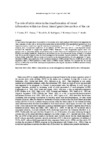The role of nitric oxide in the transformation of visual information within the dorsal lateral geniculate nucleus of the cat

View/
Use this link to cite
http://hdl.handle.net/2183/14618
Except where otherwise noted, this item's license is described as Creative Commons Attribution-NonCommercial-NoDerivs 4.0 International Licence (CC-BY-NC-ND 4.0)
Collections
- Investigación (FCS) [1293]
Metadata
Show full item recordTitle
The role of nitric oxide in the transformation of visual information within the dorsal lateral geniculate nucleus of the catAuthor(s)
Date
1994Citation
Cudeiro J, Grieve KL, Rivadulla C, Rodríguez R, Martínez-Conde S, Acuña C. The role of nitric oxide in the transformation of visual information within the dorsal lateral geniculate nucleus of the cat. Neuropharmacol. 1994;33(11):1413-1418.
Abstract
[Abstract] We have shown that application of an inhibitor of the enzyme nitric oxide synthase (NOS) effectively suppresses the visual responses of relay cells in the dorsal lateral geniculate nucleus (dLGN) of the anaesthetized paralysed cat. Such suppression seems to result from a specific reduction in transmission via acid (NMDA) receptors, since iontophoretic application of the inhibitor of NOS selectively and in a dose-dependent manner decreased the responses to exogenously applied NMDA. Responses to other exogenously applied amino acid agonists, such as quisqualate (Quis), kainate (Kain) and α-amino-3-hydroxy-5-5-methyl-4-isoxazole-propionic acid (AMPA) were largely unaffected. Furthermore, the excitatory action of acetylcholine (ACh), normally co-localized with NOS in axonal terminals within the dLGN arising from the brainstem, was also unaffected. Unlike some other actions of nitric oxide (NO), this role seems not to involve an increase in production of cyclic guanosine-3',5'-mono-phosphate (cGMP), since application of the membrane permeable cGMP analogue 8-bromo-cGMP did not alter the suppressive effect of NOS inhibitors on either visual or NMDA evoked responses. We conclude that the normal function of NO at this level of the visual system is permissive, allowing full expression of NMDA mediated visually elicited information.
Keywords
Nitric oxide
NMDA
Visual system
Cat
Dorsal lateral geniculate nucleus (dLGN)
Nitric oxide synthase
NMDA
Visual system
Cat
Dorsal lateral geniculate nucleus (dLGN)
Nitric oxide synthase
Editor version
Rights
Creative Commons Attribution-NonCommercial-NoDerivs 4.0 International Licence (CC-BY-NC-ND 4.0)






